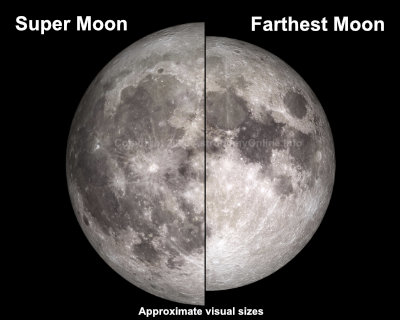There are several different named moon events. These are often all lumped under the term Super Moon although that is not necessarily the case.
What is a Blood Moon?

A blood moon is a term used to describe the appearance of the Moon near totality during a total lunar eclipse when it takes on a reddish or coppery color. It occurs when the Earth passes between the Sun and the Moon, causing the Earth’s shadow to fall on the Moon. During this phenomenon, the Earth’s atmosphere bends and filters sunlight, allowing only the longer red wavelengths to reach the Moon. This gives the Moon its reddish hue. The exact color and intensity of the blood moon can vary depending on atmospheric conditions such as pollution and cloud cover. Lunar eclipses are relatively rare events that can be observed in certain parts of the world.
What is a Blue Moon?
A blue moon is a term used to describe a rare occurrence of having two full moons in a single calendar month. It can also refer to the third full moon in a season that has four full moons. The term “blue moon” does not actually refer to the color of the moon. It is more about the timing of full moons.
The lunar cycle lasts about 29.5 days, which falls short of the 365/366 days in a calendar year. This misalignment causes occasional blue moons to happen, typically once every two to three years. The next monthly blue moon (as of this writing) is set to occur on August 30/31, 2023.
It’s worth noting that the moon does not appear blue in color during a blue moon. The term is more symbolic and represents a rare event rather than a literal description of the moon’s color.
What is a Pink Moon?
A pink moon refers to the full moon that occurs in April. It is named after the herb moss pink, also known as creeping phlox, which is a type of early-blooming wildflower. The name “pink moon” comes from Native American culture, where lunar phases were important for timekeeping. However, it’s important to note that the moon does not actually appear pink in color during this time. The term “pink moon” is symbolic and represents the arrival of spring and the blooming of flowers. The occurrence of a full moon is a natural event that happens when the moon is on the opposite side of the Earth from the sun, and its entire illuminated side is facing us.
What is a Harvest Moon?
A harvest moon is a full moon that occurs closest to the autumnal equinox. It usually happens in September, but occasionally falls in October. The term “harvest moon” originated from the extra light it provided for farmers to harvest their crops in the evenings before electricity was available.

The occurrence of a harvest moon is due to the Moon’s orbital motion and its position on the celestial sphere. During this time, the Moon rises earlier and stays visible for longer periods, providing extra light during peak harvest time. Before electric lights, this was a critical time of the year for farmers.
The harvest moon appears larger, brighter, and more orange than a regular full moon. This is due to the moon illusion, which makes the Moon appear larger when it is near the horizon. Additionally, the particles in Earth’s atmosphere can create an orange or reddish hue.
The harvest moon also coincides with the migration of birds, creating a stunning sight. It is a beautiful phenomenon that has been celebrated in art, literature, and culture.
What is a Super Moon?
A supermoon occurs when a full Moon coincides with the Moon’s closest approach to Earth in its orbit. The Moon’s orbit is not perfectly circular, so it varies in distance from about 360,000 to 400,000 kilometers from Earth. When the Moon is at its closest point, called perigee, it appears slightly larger and brighter in the sky. This phenomenon is commonly known as a supermoon.

The term “supermoon” gained popularity in recent years, although the concept has been around for a long time. It is primarily an astronomical event, but it has also gained attention in astrology. Supermoons can appear around 14% larger than a full Moon at its furthest point, but this difference is not significant to the naked eye. Additionally, the Moon may appear larger when near the horizon due to the “moon illusion.”
Throughout the year, there are several opportunities to observe supermoons. The specific dates and visibility of supermoons can vary. If you’re interested in observing supermoons, it’s a good idea to check astronomical calendars or websites for the most accurate and up-to-date information on upcoming supermoon events.
Full Moons are Not the Best Times to Observe!
While full moons can be useful to farmers, make walking outside at night easier, and be quite romantic, they are not the best time to view the moon as the moon appears as a flat, evenly lit disc, with little to no detail.
Try it some time, get a pair of binoculars or a telescope and look at the moon when it is somewhere between 25-75% full and look at the terminator line (the line between lit and unlit sections of the moon). There you should be able to see a lot of surface details like the edges of craters. As you move away from the dark portion you will notice that the level of detail drops off.
Now if you wait until there is a full moon and try to look at the same craters you looked at earlier, you will notice that the level of detail is significantly less. The reasoning is simple, the detail you are seeing is shadows created by the light on the edge of things like the crater. Without this shadow, the surface looks much flatter and washed out.

